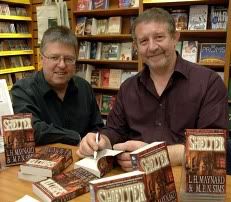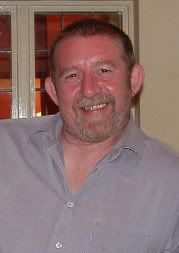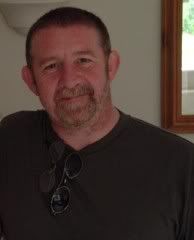Partners in Fright: The Writing Duo of Maynard & Sims
By, Vince A. Liaguno
Len Maynard and Mick Sims, better known on literary fronts by the condensed moniker Maynard & Sims, know a thing or two about consistency. They began a lifelong friendship at the age of eleven on the playground of their English elementary school, the bond of that friendship growing stronger at 18 when both young men went to work for the employers they still work for today. Both have been penning frightful fiction together since 1974.
 Like all great duos, Maynard and Sims share enough similarities to sustain their partnership while possessing enough differences to keep it interesting. One favors atmosphere; the other prefers the characters. One has been happily married for 21 years; the other is twice-divorced. One reads crime thrillers in his spare time; the other watches episodes of Lost. But at the end of the day, Maynard and Sims know that it’s their cohesiveness as a writing unit that has made them a growing force in genre fiction.
Like all great duos, Maynard and Sims share enough similarities to sustain their partnership while possessing enough differences to keep it interesting. One favors atmosphere; the other prefers the characters. One has been happily married for 21 years; the other is twice-divorced. One reads crime thrillers in his spare time; the other watches episodes of Lost. But at the end of the day, Maynard and Sims know that it’s their cohesiveness as a writing unit that has made them a growing force in genre fiction.
On the eve of the release of their third Leisure novel, Black Cathedral, the affable duo sits down for a casual chat with Dark Scribe Magazine about the new tome, how two minds create a single literary vision, and the elements of a good ghost story.
Dark Scribe Magazine: Tell us about Black Cathedral.
Mick Sims: We wanted the third Leisure book to be faster paced than Shelter and Demon Eyes. Atmosphere and characterization is how we write supernatural fiction so that is there as well but we didn’t want people to say it was too slow a read.
The story is about an ancient evil that penetrates to the modern day but also about relationships. Some of the themes cover religion and faith, revenge and family loyalties, and fear and loneliness.
The back cover blurb for Black Cathedral says: At an old manor house on a remote Scottish island, six  managers of a large corporation arrive for a week-long stay. Within days they will all suffer horrifying deaths and their bodies will never be found. The government assigns the case to Department 18, the special unit created to investigate the supernatural and the paranormal. However, this is no mere haunted house. The evil on this island goes back centuries, but its unholy plots and schemes are hardly things of the past. In fact, while the members of Department 18 race to unravel the island’s secrets, the forces of darkness are gathering…and preparing to attack.
managers of a large corporation arrive for a week-long stay. Within days they will all suffer horrifying deaths and their bodies will never be found. The government assigns the case to Department 18, the special unit created to investigate the supernatural and the paranormal. However, this is no mere haunted house. The evil on this island goes back centuries, but its unholy plots and schemes are hardly things of the past. In fact, while the members of Department 18 race to unravel the island’s secrets, the forces of darkness are gathering…and preparing to attack.
And there’s a behind the scenes piece about the writing of the book at our website where we talk about how the book began and developed.
Len Maynard: The Department 18 idea grew out of the book. We wanted a team to go over to the island to investigate what had happened there, and the idea that it should be a Government backed Department just evolved. Once this idea was in place it gave us an opportunity to explore the back story more, tying things in with phenomena that the Department had investigated or were currently investigating.
Dark Scribe: Which character was your favorite to write?
Mick Sims: I’d say Jane Talbot. She has family issues she tries to resolve, as well as unresolved feelings for one of her colleagues. That all comes to a head at exactly the wrong time for her and she has to make hard decisions.
Then there is the issue of whether she knows she is psychic or whether she is simply repressing the powers others see in her. It forms part of what we tried to make as a powerhouse finale.
Len Maynard: For me it was Robert Carter. A troubled man, trying to exorcise his own demons only to have a whole new batch coming along to take their place. He’s a man who has loved and lost and doesn’t really believe that that is preferable to having never loved at all. So, he’s a loner, and something of a misanthrope. I quite enjoy writing about people like that.
Dark Scribe: How did the writing collaboration of Maynard and Sims come to be? How long have you been writing together?
 Mick Sims: Our writing settles into four main periods - the early traditional ghost story period of about ten years from 1974. A middle period when we wrote a lot without sending much off for possible publication. During this period we wrote and broadly destroyed about 11 novels, and wrote numerous stories. This 'barren' period lasted about ten years from about 1984. The third period began around 1994 and is when we began again in earnest and happily continues to the present day. The fourth ten year period began around 2004 with the publication of what currently is the last story collection, Falling Into Heaven. This phase is dominated by the novels.
Mick Sims: Our writing settles into four main periods - the early traditional ghost story period of about ten years from 1974. A middle period when we wrote a lot without sending much off for possible publication. During this period we wrote and broadly destroyed about 11 novels, and wrote numerous stories. This 'barren' period lasted about ten years from about 1984. The third period began around 1994 and is when we began again in earnest and happily continues to the present day. The fourth ten year period began around 2004 with the publication of what currently is the last story collection, Falling Into Heaven. This phase is dominated by the novels.
I started around 1973, with a short story in reply to one Len had written. Then he did another, and so did I and we carried on for the next couple of years. We sent an early ghost story to a paying magazine, London Mystery, and it was accepted and we got paid. We then sent a story to Hugh Lamb, one of the top anthologists of the time, and he accepted that one too.
I didn’t enjoy secondary school, but I did enjoy writing essays in English Lit. I did vaguely think I would be a teacher and write part-time, without really knowing what was involved. Instead, I joined a bank and am still there after 36 years. I had begun to read short stories as a teenager, most of which were supernatural, so when Len produced a short story, out of the blue, it felt natural to try to replicate what he’d done. I had two good English teachers, a Mr. Deverson in primary and a Mr. Mandelson at secondary - both of whom inspired me. But it was Len’s first story that got me started.
Len Maynard: I started writing in a kind of knee-jerk reaction to the fiction I was reading at the time. I  certainly had no aspirations to become an author during my school days. I enjoyed writing the odd story for my English class and was given great encouragement by my English master Mr Wilson, but I would never have guessed then that I would be writing fiction for the rest of my life.
certainly had no aspirations to become an author during my school days. I enjoyed writing the odd story for my English class and was given great encouragement by my English master Mr Wilson, but I would never have guessed then that I would be writing fiction for the rest of my life.
I remember the story Mick is talking about. I’d been reading my way through the Pan Horror series and one day just thought to myself, ‘I can write these.’ I found out rather quickly that writing publishable short stories was not as easy as I’d thought. That first story was really dreadful. But if it inspired Mick to write then it served a useful purpose.
We wrote as individuals for a while then realized that we would be competing for the same markets, so the sensible thing seemed to be to pool our resources. And we’ve been writing together ever since.
Dark Scribe: Can you describe the physical process/logistics of writing a collaborative novel? Does each of you write so many words and then hand writing chores off to the other, like a literary relay, or is there a more fluid process at work? How does it all come together?
Mick Sims: It’s become more fluid as the years have passed. Initially, we would finish each others stories and argue about which version was better. We’d spend hours discussing a single word if we felt passionately enough about it.
Often one would run out of steam with an idea and simply pass it over to the other who would finish it. Sometimes a story would be finished and the other would revise it – examples would include a 7,500 word story that became 13,000 and a 14,000 that ended as 7,500.
With the novels, each has been different. We find it is important that a book has a single voice – an author point of view, a narrative drive the reader can connect with. Luckily our styles have developed over the years into a single M&S style so there is never a case of anyone being able to see the joins.
 Shelter was written by one of us and the other completely revised it, moving chapters around and deleting characters and fleshing out others.
Shelter was written by one of us and the other completely revised it, moving chapters around and deleting characters and fleshing out others.
Demon Eyes was written by one of us and the other merely touched it up with minor revisions.
Black Cathedral was started by one of us, carried on by the other and then passed back to the original author who finished it, adding chapters inserted to the earlier parts.
With each book we spend days at the end reading it together, page by page, for grammar, continuity, repetition and other flaws we find.
Len Maynard: We used to brainstorm, sometimes for weeks on end. I remember one novel we planned early on in our careers was discussed at length and completely story-boarded - a process that went on for weeks if not months. In fact it took so long to plan we both ran out of steam on it and it was shelved. We refined the process after that. Mick has said it all really.
Dark Scribe: Are there aspects of the novel writing process that one of you gravitates to more than the other?
Mick Sims: I enjoy atmosphere, creating a mood in a scene that lends itself to allowing the characters to feel as if they are in danger, even if the real horrors are some way off.
Creating characters and seeing how they develop is also fun, with surprises at what they actually end up doing. Sometimes the characters create the plot lines as they interact in ways that could never be plotted out beforehand.
Len Maynard: For me, it’s characters every time. I find the characters propel the plot. So many times I have had to go back and change my original ideas because the characters have taken me to a place I wasn’t expecting to go. I very rarely plan anything out before I start writing. I just start with one character, maybe two, and see where they take me.
Dark Scribe: Have the two of you ever reached a literary impasse during work on any of the novels – a moment where one saw the story going in a particular direction that the other didn’t? How’d it resolve?
Mick Sims: With Shelter it definitely went one way at first. When the other revisedit, it [the story] went a  different way. It started a discussion that actually ended with the story going a third and unexpected way about three quarters in. One character was deleted completely and their scenes that survived were given to another character.
different way. It started a discussion that actually ended with the story going a third and unexpected way about three quarters in. One character was deleted completely and their scenes that survived were given to another character.
Black Cathedral started with the management team on the island. Then the story took off in a different direction with the plan being that about halfway through it collected back at the island and took off from there. What happened was that one of us wrote the opening fifth. The other took it on and it went somewhere else entirely. That led to a dead end so the other one took it back and chopped chapters around, changed some character perspectives and added the complete Ley lines and Jesuits story. That took us to the end of the book.
Len Maynard: I think we have been writing together for so long now that we respect each other’s strengths and recognize each other’s weaknesses. I know that if I hit a brick wall, and this used to happen a lot with the early short stories, I could pass it to Mick and nine times out of ten he would know how to bring the story to a satisfactory conclusion and vice versa. A writing partnership like this is based on trust. Ego tends to be put to one side for the greater good of the story. But this is something we have developed over thirty five years. It wasn’t always like that, but we’re grown ups now.
Dark Scribe: Having penned your third supernatural horror novel, what makes a good ghost story? Are there elements germane to the ghost story genre that must be present? If so, how does one inject innovation into the formula?
Mick Sims: I think when we began we were writing ghost stories in the traditional English style of M.R. James although our influences were more the writers who had emulated him, like R.H. Malden and Andrew Caldecott, as well as E.F. Benson and H.R. Wakefield. They were very much full of atmosphere, with a deliberately stylized English setting of the thirties with academic gentlemen drinking port, playing chess and finding gruesome ghosts in churches and old furniture.
Over the years we have evolved our ghost stories so that they feature much more of the human character in them. The hauntings derive from a flaw in the human character and often innocent as people they nevertheless create tensions in people and situations around them that leave a chink for evil to slip through.
A good ghost story must be believable, so the characters have to be empathetic and realistic. The setting has to be familiar so that even if the reader has never been to such a place they can recognize it in their mind's eye. The ghost or haunting has to have a purpose that derives from either the character or the setting so that what happens appears inevitable and natural.
 Len Maynard: The ghost story has not been preserved in aspic. It’s one genre that is constantly evolving. I remember reading Robert Aickman’s Ringing the Changes and thinking it a very modern take on the ghost story, before realizing it was written when I was just two years old. But Aickman was such a forward thinking author. And there have been many willing to push it further. Ramsey Campbell, of course, and writers like Terry Lamsley who produced some superb collections of ghost stories in the 1990’s. The art is in keeping things as fresh as possible when dealing with what is, after all, one of the oldest forms of fiction. It’s the basic campfire story, the one where you try to scare the hell out of your audience. Unlike vampires, werewolves and the like, the ghost is a much more elusive, amorphous horror. It could be anything from a moving shape glimpsed out of the corner, to a shrieking mouth bursting from the wallpaper. It’s a very wide area in which to work.
Len Maynard: The ghost story has not been preserved in aspic. It’s one genre that is constantly evolving. I remember reading Robert Aickman’s Ringing the Changes and thinking it a very modern take on the ghost story, before realizing it was written when I was just two years old. But Aickman was such a forward thinking author. And there have been many willing to push it further. Ramsey Campbell, of course, and writers like Terry Lamsley who produced some superb collections of ghost stories in the 1990’s. The art is in keeping things as fresh as possible when dealing with what is, after all, one of the oldest forms of fiction. It’s the basic campfire story, the one where you try to scare the hell out of your audience. Unlike vampires, werewolves and the like, the ghost is a much more elusive, amorphous horror. It could be anything from a moving shape glimpsed out of the corner, to a shrieking mouth bursting from the wallpaper. It’s a very wide area in which to work.
Dark Scribe: There seems to be renaissance of sorts with horror fiction of late that focuses less on the blood-and-guts, go-for-the-jugular approach and more on the intellectual and literary, if you will. Which of the new crop of dark scribes have gotten your attention?
Mick Sims: I’ve been lucky enough to meet loads of people at different conventions and what lovely people they are. Gary Braunbeck is a smashing bloke, as is Bill Gagliani. Brian Keene always makes you welcome, as does Sarah Pinborough. Jeremy Shipp is helpful, and William Simmons writes good fiction as well as reviews. Gene O’Neill became a friend. Mark McLaughlin was very kind, and writers like Peter Tennant, Paul Finch and Steve Duffy are under appreciated.
Len Maynard: All of the above. When we were editing Enigmatic Tales and Darkness Rising we soon came to realize that there is very deep pool of talent out there. Bill Gagliani’s Wolf’s Trap was magnificent. It was the best werewolf story I’ve ever read. Absolutely loved it and I’m eagerly awaiting the sequel. Gary Braunbeck is an innovative writer and a great stylist, who writes with true emotional depth. I’m waiting to see a decent collection of Steve Duffy stories, because he is up there with the best, and both Peter Tennant and Paul Finch are long overdue for a breakthrough. Sarah seems to be doing all right for herself.
Dark Scribe: Having an active readership on both sides of the pond, how do your American readers differ from your UK readers? In what ways are they the same?
Mick Sims: Language is one thing, surprisingly. A thread on a message board in US talked about the phrases and words UK writers use and how the American audience doesn’t understand them and how it breaks the flow of the story. Not quite sure what words or phrases they mean as in all the novels we have not used British ‘jargon’. In some of our earlier stories the use of a specific English word or meaning of word was important to the plot, but the novels are more general than that.
American readers seem to like their stories to be fast-paced and stripped down. British readers like slower pacing with plenty of background.
Len Maynard: I don’t think the differences are that great. The story is everything. If you engage with the reader it really doesn’t matter what the setting is, what language you’re using or if it’s UK or USA based.
Dark Scribe: What’s life for each of you like when not penning the next supernatural tale of terror?
Mick Sims: I’ve worked for over 35 years in a bank so am now in quite a senior position. That means lots of meetings, laptop work and deadlines. At home I have a wife of 21 years – the marriage, not the wife – and a daughter of 14 whose natural quest for independence is a daily battle between boundaries, safety and pure tearing out of hair. I like reading, crime and thrillers mostly rather than ‘horror’, gardening and socializing a bit.
Len Maynard: I’ve worked for the same gemstone company for the last 40 years and I’m busier and working longer hours now than I’ve ever worked before. I used to cut gemstones but now I’m finding my job veering towards the IT side of tings. I designed and created the company website and compile and edit the company catalogue. I’m now a bachelor again after two divorces and quite enjoying the lifestyle. I write nearly every day so spare time is severely limited, but I am a sucker for sitting in front of the TV and watching DVD’s. I tend to buy complete a series of particular program, e.g. Lost, The Shield, and watch all the episodes back to back. It’s an indulgence and a delicious one.
Dark Scribe: What frightens you?
Mick Sims: My daughter’s safety, the cruelty in the world, spiders, dying too soon (my dad died of a heart attack at 59), time passing too quickly (my mum had Alzheimer’s).
Len Maynard: Running out of time before I’ve done all the things I want to do. Horror films scare me to death...well, a lot of them do. I’m not good with things that make me jump, and horror films have a habit of doing that.
Dark Scribe: Can you give DSM readers a hint or two about the next Maynard & Sims novel? Sticking with Leisure for the next release?
Mick Sims: Definitely Leisure, Don and his team are so good to work with.
Black Cathedral introduces Department 18, a unit within the British secret service that investigates paranormal events. We didn’t have any definite plans to expand on that, it was almost just a feature of the novel. But Don liked the idea, and suggested the strap line on the cover ‘A Department 18 novel’.
So, Black Cathedral is the first in a planned series. The second novel, a sequel to Demon Eyes, is underway. The sequel to Black Cathedral, also featuring the Department is drafted out.
Len Maynard: I should mention that the sequel to Demon Eyes is also a Department 18 novel, featuring some of the same characters that appear in Black Cathedral, but also a few new ones. It’s called Breathers and picks up the Demon Eyes story three years on.
Early reviews seem to like the idea as well: "There’s enough potential in the concept of Department 18, to persuade me to look out for future books" and "...a winner here and I think that they have themselves a franchise in the works with the characters that make up Department 18. This is a book to watch out for, and one that really grabs you from the first chapter on. L.H. Maynard and M.P.N. Sims are a horror duo that knows how to scare the reader and suck them down into their horrific stories. Pick this one up when it hits book shelves in January and get ready for a whole new paranormal experience with Department 18."
For more about the writing duo of Maynard & Sims,
visit their official author website.




Reader Comments (1)
I have to say Len and Mick published my first ever short story..I remember when I got their letter saying they'd take it I was so excited I drove all the way to work with the boot of my car up!
It was a very happy day xx Good interview chaps - always interesting to read how people that write together manage it.
Sarah x